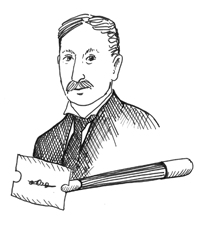STRANGE BUT TRUE- Camp Gillette: He paved the way for the 'Brazilian'

DRAWING BY DEBORAH DERR McCLINTOCK
Q. Who was the "king" of modern shaving," well known to many a World War I soldier? –J. Stalin
A. Make that King Camp Gillette (1855-1932), American inventor and businessman who in 1903, along with William Nickerson, introduced the disposable blade, some 25 years after the first safety razor, says Jack Challoner in 1001 Inventions That Changed the World.
Before the invention of the safety razor, the dangers in shaving were evident in the traditional terminology of the straight "cut-throat" razor, with shaving done by barbers or trusted family members. Defying those skeptics who believed it impossible, Gillette fashioned an ultra-thin, carbon steel, double-edged blade and eventually struck a deal to provide safety razors and blades to every member of the U.S. Army during World War I.
Later innovations included the electric– or dry— shaver by Jacob Schick (1929), the long-lasting stainless steel blade by the British company Wilkinson Sword (1965), then even safer replaceable blade cartridges (around 1970), and entirely disposable razors (1975).
Currently on the drawing board are eco-friendly recyclable and biodegradable razors.
Q. What's the story behind the heart-stopping "Cerbera odollam" tree of Kerala, India? –M. Gandhi
A. Named after Cerberus, the hound of Hades of Greek mythology, its narrow, dark green leaves resemble the common oleander, says Amy Stewart in Wicked Plants. Sprays of starry white flowers release a perfume as sweet as jasmine.
Its fleshy, green fruits are like small unripe mangoes, except that the white nut meat contains enough cardiac glycoside to stop the heart within three to six hours!
This powerful resource is not lost on the locals. The suicide rate in Kerala is about three times India's average, with about 100 Keralites attempting it every day and 25-30 succeeding. Poisoning is the choice of 40 percent of the despondents, with women in particular favoring a mashed odollam final "dessert."
Because the symptoms resemble those of a heart attack, the seeds have also been used to commit murder. Recently, a team of scientists used liquid chromatography and mass spectrometry to prove that many of those who had died under mysterious circumstances had actually been fed odollam.
Q. What do today's horse racing jockeys do that the earliest jockeys didn't, helping improve race times dramatically? Is it a matter of better aerodynamics? –E. Arcaro
A. The late 19th century saw a radical innovation where jockeys abandoned a comfortable upright posture– "tall in the saddle"– for the hunched-over, short-stirrup style seen today, says Steven Blau in Physics Today. By 1910, when the style became universal, race times had dropped by more than five percent, an improvement during that first decade greater than in the hundred years since!
Yet, surprisingly, according to Thilo Pfau of the University of London's Royal Veterinary College, the gain is due less to positional aerodynamics than to synchronization of movement between horse and rider. The London group determined that jockeys today do not undergo much vertical displacement as the horse gallops; rather, they strenuously pump their legs in such a way as to absorb the horse's motion. This way, the horse does not expend unnecessary energy lifting and lowering its cargo. Moreover, the horse's forward speed varies over the gallop cycle so that when the horse is moving faster than on average, the jockey moves slower. "That out-of-phase response could help the horse execute a smoother, more energy-efficient gallop."
#